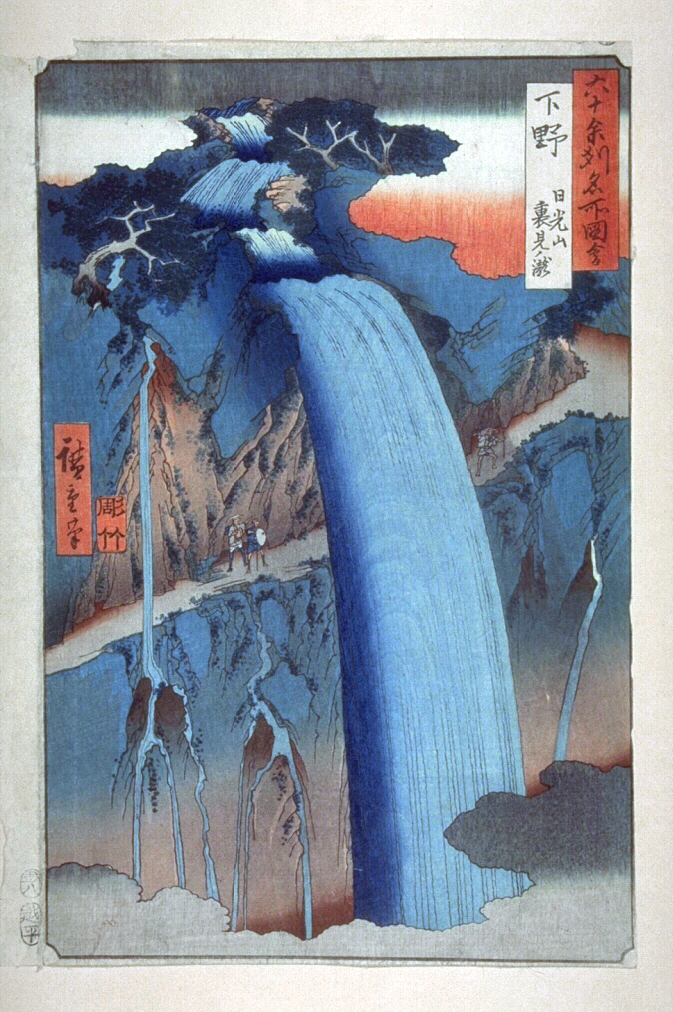Activity
Artist Profile: Utagawa (Ando) Hiroshige (1797–1858)
Learn about the Japanese artist Utagawa (Ando) Hiroshige (1797–1858).

The Urami Waterfall in Niko from Picture of Famous Places in the Sixty-odd Provinces, 1853.
Utagawa (Ando) Hiroshige was born in 1797 in Edo. His father was the warden of the Edo fire brigade that serviced the shogun. In 1809 at the age of thirteen, Hiroshige lost both parents and inherited his father’s position. In 1810 or 1811, he sought in vain to learn ukiyo-e under the most powerful master of Kabuki actor portraits, Utagawa Toyokuni (1769–1825). Toyokuni, having more students than he could handle, turned Hiroshige over to his friend Utagawa Toyohiro (1773–1829).
Toyohiro’s interest in landscape prints, a minor genre at the time, influenced his young apprentice. For some years, Hiroshige worked on book illustrations, designs, and inexpensive prints. In 1822, at age twenty-seven, Hiroshige retired from his position as a fire warden and became a full-time artist. It is difficult to explain why Hiroshige, with his samurai status (albeit one of low rank), wanted to become an ukiyo-e artist. The financial state of the lower-ranking samurai had become increasingly difficult, and scholars have surmised that when young Hiroshige started training with Toyohiro, he might have wished to earn extra income for his household.
Hiroshige’s first landscapes were ten prints of Famous Places in the Eastern Capital, published in 1825. Here, he boldly adopted Western conventions to create a new hybrid style. His work at this time already revealed his particular interest in changes in nature due to weather, time, and the seasons.
In 1832, Hiroshige reportedly traveled the Tokaido Road to Kyoto on official business; he was accompanying an entourage of the shogun’s officials with their annual gift of horses to the emperor in Kyoto. The Japanese traditionally celebrated the first day of the eighth lunar month by exchanging gifts. The trip must have been an eye-opening experience for Hiroshige, a city person who had heard so much about the Tokaido Road. Returning to Edo, Hiroshige immediately launched on his monumental project of publishing the Fifty-three Stations of the Tokaido Road. It was scarcely a year since Hokusai had published his famous Thirty-six Views of Mount Fuji, of which Hiroshige was undoubtedly aware.
In 1835, Hiroshige was involved in publishing the Sixty-nine Stations of the Kiso Road, comprising seventy prints. The project began as a collaboration with another artist Eisai Eisen (1791–1848), but Hiroshige took over the project, designing forty-six prints in all. The Kiso Road was an alternative highway connecting Edo to Kyoto through mountainous regions and was thus difficult to travel, especially in winter. Hiroshige’s evocative style portrayed a true sense of nature and the people living in perfect harmony.
In 1856, Hiroshige began his largest series, One Hundred Views of Edo. For a native resident, the theme of Edo was always in Hiroshige’s mind. In the vertical format of the standard oban size, Hiroshige revealed his mature style in depictions of famous places in the gigantic metropolis that fascinated all people. In 1858, Hiroshige died suddenly at the age of sixty-two, a victim of the cholera epidemic that plagued Edo and claimed 28,000 lives.




